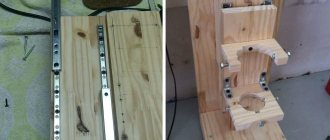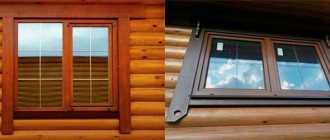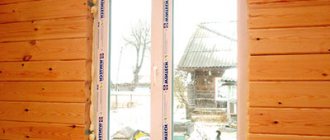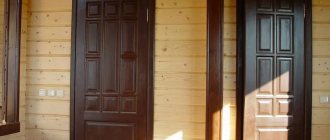In order to correctly calculate the size of a window in a wooden house, it is necessary to take into account not only technical limitations, but also recommendations for the correct organization of the design of the premises and the entire house as a whole, since the correct position, size and shape of windows can not only improve the appearance of the house, but also significantly improve ergonomics of rooms.
In practice, the choice of window size and configuration occurs in the form of a search for a compromise between financial and aesthetic factors, since the cost of non-standard glazed windows is 50-60% higher.
At the same time, it is necessary to take into account that the strength and thermal parameters of the window have a higher priority and it is not always possible to cut a window exactly where the designer recommends.
This review discusses the main recommendations, knowledge of which will make the house more comfortable and bright and avoid mistakes made during the installation of plastic windows in a wooden house.
General provisions and information: how to take measurements correctly for a plastic window
First of all, you need to know that the depth of the opening is initially determined, and only then everything else. It is very important to take into account all the nuances, without exception, otherwise you may later find yourself in a situation where the delivered window simply does not fit, and the installer, and even the manufacturer, seem to have absolutely nothing to do with this, because you provided them with the wrong dimensions yourself. Therefore, treat the work with full responsibility, so that the Dunno principle “it will do” does not become the reason for wasting money, because the design costs far from a penny.
Helpful advice
Measuring plastic windows with your own hands should only be done if the installer for some reason cannot perform such actions. It would be optimal to entrust such a complex and responsible matter to a real professional, and avoid many annoying misunderstandings and unnecessary problems.
So, the measurement of the opening for plastic windows should be carried out both from the inside and from the outside of the building. This is how the depth of the opening is determined. It often happens that when taking qualitative measurements, it suddenly turns out that your window opening has a very significant skew, then the dimensions of the final product will have to be increased, according to the measurements of the skew itself. Most often, such problems can be observed in panel buildings, where large slabs and blocks already come cast from the factory.
After you have already measured the window opening from the outside, you should also measure the inside of it, and then compare the results. This will help you take a sensible look at the situation, because ideally all the numbers should practically coincide, but if not, this will also have to be taken into account when making the final calculation. You can correct unevenness by installing plastic slopes, and experienced craftsmen do not recommend abandoning such accessories, as they perform many functions other than decorative ones. For example, they prevent the appearance of condensation and increased humidity, which can lead to the formation of black mold, which will be very difficult to combat later.
Selection of fittings and sealing material
The fittings, of course, must be beautiful, but great responsibility lies precisely in strength, because it will have to withstand heavy loads of the entire opening and closing system. That is why it must be made of high-quality, reliable material.
The sealant cannot lose its original characteristics over time, dry out or deform.
Measuring window openings: general rules for do-it-yourself work
It is no secret that all construction and repair work is subject to general mathematical rules. This statement fully applies to such an important matter as measuring window openings for plastic windows. Existing measurement rules make it possible to quickly and easily install exactly those plastic windows that are ideal for a particular room. So what are they:
- the proposed measurer must have an analytical mind, good spatial thinking, and have personal experience in installing windows;
- measurements must be taken both inside and outside. The inside of a plastic window is always larger than the outside;
- before starting measurements, it is necessary to complete all preparatory work (brick laying, removing old plaster, etc.);
- in many houses (especially panel houses) there is a misalignment of the window opening. In order to avoid through gaps, it is necessary to maintain the minimum standards of plastic window panels: the size of the inner part of the window is 30-40 mm in width and 15-20 mm in height larger than the size of the outer side;
- Before you start installing a window, you must compare its dimensions with the calculations that were made at the initial stage. A mechanical error may be made, which will nullify all the work carried out in the previous stages.
These rules are mandatory for any craftsman involved in taking measurements and installing windows and double-glazed windows in apartments, offices and private homes.
Measuring the width of the window from inside the room
With the window closed, use a plumb line to check the deviation of the opening from the vertical (blockage). This is necessary to eliminate such an unpleasant situation when a plastic window, when installed level (and level installation is a prerequisite for installing PVC windows), suddenly rests with two diagonally opposite (less often adjacent) corners against the walls of a curved opening. To avoid such an embarrassment, we take a plumb line and hang it next to the window frame from the top of the opening to the window sill at two points, as shown in the figure (left diagram - if the opening is blocked to the left; right - if the opening is blocked to the right):
The window opening is shown in gray, and the plumb line in blue.
If there is a blockage, then we calculate the “useful” width of the opening - the distance between points A and B.
If the blockage is insignificant (no more than 10 mm) or there is none at all, then we will consider the “useful” width to be the entire width of the opening next to the window frame.
A plastic window, unlike an old wooden one, as already mentioned, must necessarily be smaller than the window opening, i.e. There must be an installation gap between the window and the opening. Therefore, from the obtained value of the opening width, we subtract 40 - 50 mm for the gaps and obtain the estimated width of the window. But it will be possible to finally decide on the width of the plastic window only after the sizes and proportions of the quarters have been identified. For this purpose, external measurements are taken.
Measuring the width of the window from the outside
Open the window and measure the distance between the side quarters, i.e. determine the width of the lumen.
Using an awl or screwdriver, determine the depth of the side quarters. It is advisable to “scan” each quarter in at least two places: above and below, to get an idea of its proportions. We save the result of these measurements on paper in the form of a schematic drawing.
Comparing the data on the proportions of the side quarters and the expected width of the window, we estimate how deep the window with such dimensions will extend beyond the left and right quarters and, if necessary, adjust the width of the window downward. It is desirable that the frame profile is “hidden” behind the side quarters by no more than half its width, i.e. maximum 35 - 40 mm. But it would also be wrong if the window does not extend beyond the quarters at all, although sometimes this happens if the quarters are missing or very small (20 mm or less). If there is a large difference in thickness between the right and left quarters, it will also be better to reduce the width of the window in order to achieve the maximum possible symmetry of the window along the quarters on the street side, sacrificing the proportionality of the internal side gaps (the problem with the gaps can be corrected when installing internal slopes).
We have decided on the width. The next step is to measure the height. Determining the height of a plastic window, as well as the width, is carried out by measuring the old window from the street and from the inside. Only the height, as opposed to the width, I recommend starting to measure from the outside, and only then from the side of the room.
Measuring the height of the window from the outside
We open the window and measure the distance from the top quarter to the base of the metal ebb, if it is, of course, installed. I call the base of the tide the line where the tide joins the window frame. If there is no low tide, then we simply measure the clearance from the top quarter to the bottom. The resulting value can be considered the estimated height of the future plastic window. But this assumption must be verified:
- First, use an awl or screwdriver to scan the top quarter to determine its size, and be sure to measure it at the extreme points (left and right) to make sure you can insert the top edge of the window 15-20 mm behind it. If the upper quarter at least on one edge turns out to be less than 40 mm, then the value of the estimated height will have to be reduced by 20 millimeters (or even by 30 - 40, if the quarter turns out to be less than a centimeter or completely zero).
- Secondly, it is advisable to measure the lower quarter, although this is more difficult to do. To do this, you will have to bend the base of the ebb from the window frame in at least one place (preferably in the center) and measure the depth of the quarter (considering that the ebb is usually tightly pressed to the quarter, i.e. lies on it, the depth of the quarter can be measured from the low tide, counting its upper edge of the quarter). The ideal size for the lower quarter is 25 mm. If the quarter turns out to be, say, 10 mm less than this value, then we reduce the estimated height of the window by the same value, i.e. by 10 mm. Accordingly, if a quarter is less than ideal (25 mm) by 20 mm, then we reduce the height of the window from the expected one by 20 mm. But if the quarter, on the contrary, turns out to be more than 25 mm, then in this case there are two options: either we leave the existing value of the expected height unchanged, but during installation we get a large bottom gap (which does not reduce the quality of installation, but only leads to excessive foam consumption ), or in the same direct proportion we increase the size of the window, but then during installation we cut off the interfering part of the lower quarter with a hammer drill, thereby increasing the duration of the work and causing a lot of inconvenience to the neighbors.
Standard parameters and properties of window systems
To make plastic window structures, you will have to contact a construction company, or if you want to save money, go directly to the manufacturer, and they will offer you a standard range.
As a rule, the sizes of windows in a frame wooden house are as follows:
- Single leaf (height 400-1470 mm, width 400-870 mm);
- Double-leaf (height 570-1470 mm, width 870-1470 mm);
- Three-leaf (height 1170-1470 mm, width 1770-2070 mm).
Standard sizes of windows in a house from manufacturers in the Russian Federation
Choosing a larger sash size is not entirely safe: glass is a fragile material and requires a special binding. If you are planning a balcony on the second floor, then the door dimensions will be standard (height 2100-2200 mm, width 700-900 mm).
All of the listed window sizes are produced by most construction companies, and if you want to make an exclusive order, the window set will be significantly more expensive.
Standard parameters of window structures are designed for the same type of openings in multi-storey panel buildings, and the demand for them is quite high, but construction companies carry out orders for individual sizes much less often. Therefore the cost is much higher. When designing, take into account the future location of all furniture and its dimensions.
Distance from window to floor
A typical standard window should be located at a height of 80 to 90 cm from the floor : this provides a good view for both a sitting and a standing person, and you can place a desktop or other piece of furniture under the window sill. The upper edge of the block is usually located at a height of 220 to 230 cm from the floor.
Special requirements apply to windows in the premises of a wooden bath: a bath room does not require good lighting, but the preservation and retention of heat is very important. Following these requirements, a standard bath window in a steam room is no larger than 600×600 mm, and in a relaxation room the window can be made larger, for example 1000×1200 mm.
Maximum size of plastic window structure
When choosing large individual window structures with increased sash area, you need to know the existing requirements set out in special building regulations:
- The area of the entire structure should not be more than 6 square meters. meters. Otherwise, it may not withstand the wind load, and in unfavorable weather conditions the glass unit may crack and crumble into fragments.
- You should not ignore safety rules: weather conditions in different regions of Russia are changeable and unpredictable. Large blocks should have partitions, and the area of the doors should not be higher than 2.8 square meters. m. The maximum permissible size of the sashes is 110×240 cm. When designing window openings, keep in mind that a large structure can quickly fail. A metal-plastic profile with a two-chamber (three-chamber) double-glazed window will be very heavy, and due to the large weight, the fittings will soon begin to sag and sag. In this case, the sash will wear out and it will begin to creak; using such a design will be inconvenient and even more unsafe. If you decide to install an arched window, then its radius should not be less than 35 cm. The requirements for large sashes will be the same as for conventional turning systems.
View of windows with panoramic glazing of a house
Failure to comply with these requirements may pose a threat to residents, so you should not ignore them even with panoramic glazing. If you want to provide your home with good lighting, you need to order modern panoramic glazing designs made from special tempered glass or so-called triplex. Of course, their cost is much more expensive, but they are much safer and will provide all residents with a good view. When choosing what size window to order for your home, you should take into account the climate and wind load in your region. If winters are cold, then heat will escape faster through double-glazed windows, which means an annual increase in heating costs.
The size of the hole for the window block
The dimensions of wooden windows in a frame house will not coincide with the dimensions of the opening. They will be large; this tolerance is needed for the subsequent installation of the casing and window sill. You need to step back about 5 cm from the planned height of the lower edge of the window: 4 cm is the thickness of the window sill and 1 cm is the layer of polyurethane foam . The width of the hole exceeds the window by 14 cm: 5 cm on each side for installation and installation of the casing and 2 cm on both sides for a layer of polyurethane foam for durable fastening.
The opening at the top is about 10 cm larger: this gap is left because over time the beam will lower. When making calculations and planning, it is worth taking into account the lower edge of the frame; it should not be located at a height of more than 1 m from the floor level. In this case, it is not very convenient to rest your hands on the windowsill, and the lighting in the room will not be enough.
Requirements for profiles and double-glazed windows
When choosing a window unit, you also need to choose the right profile and double-glazed windows. It will be more difficult to choose if you install metal-plastic frames: since the number of offers on the construction market is growing, and you need to know exactly which criteria will suit you best.
Here are some basic and important requirements:
- The number of cameras in double-glazed windows. For country-type houses or for premises that will be used only in the summer, you can install a single-chamber double-glazed window. However, in winter, such a package will not be enough. You will have to purchase double-glazed windows with air layers; they will protect your home from freezing, although the cost will be significantly higher than single-layer packages.
- Number of chambers in a plastic profile. The more chambers, the better the profile retains heat, because air is the best heat insulator. For a capital project, it is customary to choose a 3- or 4-chamber double-glazed window.
- Selecting a seal. Very little attention is paid to the choice of this material, but thanks to the seal, all cracks and drafts are eliminated. Cheap and rubber material will begin to “tan” and cease to perform its main functions. Some manufacturers offer transparent elastomer seals: their cost is higher, but the protection against cold is much better and of higher quality.
- Accessories. The main rule is that you shouldn’t skimp on it. Cheap locks, clamps, handles will quickly fail, and weakened hinges and a thin frame will certainly lead to distortion and sagging of all sashes. As a result, you will have to spend money on expensive repairs, so the savings do not justify the investment.
Choosing window systems for a frame house is a very complex and responsible task, and it is better to discuss its solution with craftsmen and professionals. The cheapest and most accessible option is windows made of metal-plastic; they can be ordered from any construction company. Plastic window structures have a significant impact on environmental friendliness, so when choosing them you need to decide in advance the issue of high-quality ventilation, but at the same time they retain heat well and will last you much longer during operation. The rooms will be light, cozy and comfortable, and a well-calculated total glass area will give you a sufficient level of illumination.
Self-measuring the window opening - can a beginner do it?
There are some features and requirements for correct and accurate taking of window measurements, subject to which even a beginner can cope with this task:
- To correctly take window measurements, you must have spatial imagination, as well as an understanding of the design of the house structure and the window frame.
- Measurements must be taken from the inside and outside. This will give an accurate result. If it is not possible to go outside due to the high floor, the measurement is carried out through the window sash.
- If the measurement is carried out for the customer, then it is necessary to clarify whether the outlines of the current opening will be preserved until the finished window frames arrive. Sometimes the dismantling of old frames is carried out by the owners carelessly, with cleaning of the concrete plaster or removing an additional row of bricks.
- When measuring window openings in panel houses, you need to take into account their possible distortions. This will prevent the appearance of through cracks. Very often there is a discrepancy between the parameters of the lower and upper parts of the window.
- When taking measurements as a performer, it is necessary to agree on the external parameters of the future window, how far it will protrude from behind the wall.
- When measuring the window span, it is also necessary to take into account the location of the ebb. The lower level of the window frame should not be lower than the edge of the projection on the outside.
- Having decided on the dimensions of the future window frame, it is necessary to once again compare them with the internal results of the opening measurements to ensure that they are carried out correctly.
- An important indicator is the shape of the window, as it can be varied. For example, arched, rectangular, trapezoidal and so on.
What tools are needed?
To take window measurements you need to have precise tools. To check the angle of repose, which should be 90 degrees, use a telescopic ruler with a digital designation and a spirit level to check the angle of the masonry slope at 90 degrees. Laser instruments—rangefinders—give very good measurement results .
Checking the slope angle can also be done by measuring two diagonals. If they differ from each other, then the angle is not right, so such an opening cannot be accepted for installation; it will need to be aligned.
In addition to serious measuring tools for measuring an opening, you will need simpler ones that are available to any home craftsman, such as pliers, a folding meter, a level, a tape measure, a chisel, a knife, a pen and a notepad.
Requirements for tools for measuring window openings:
Laser tape measure , the error should be no more than 3 mm, the model should have a viewfinder, a level gauge, calculator and area calculation functionality, screen backlighting, the ability to determine inclined lines and save measurements.- A telescopic ruler with a display must have at least 2 built-in levels, millimeter divisions and fixing screws securing the sliding sections, the size of the ruler must be larger than the measured values, sizes from 3 m are universal.
- The spirit level must have a length corresponding to the dimensions of the window niche, the body must be made of a light but durable alloy, and the measurement accuracy must be high. When choosing this tool, you can check it by placing a sheet of paper under it; a professional spirit level should determine it by changing the position of the bubble.
How to properly measure a window using improvised means
To find out whether there is a quarter in the window or whether it is solid, it is worth taking several measurements, both inside the house and outside.
Correct measurement of a window opening for a plastic window implies taking into account the possible distortion of the wooden structure
You need to do the following:
- measure all parameters: height, width and length;
- calculate the dimensions of internal and external structures;
- add into the calculation the dimensions of additional parts, ebb and flow and mosquito nets.
After all the parameters have been calculated, it is necessary to agree with the manufacturer and installer of the structures on the type of binding, color, type of glass unit and other details.
conclusions
Now you know how plastic windows are installed, so you can safely get to work. The final check of all elements can be carried out only 24 hours after completion of installation (then the foam will have already “set”).
The described technology is quite applicable to balcony glazing, although it also has its own nuances - such as, for example, installing a parapet to create a partition.
Plastic windowsInstallation of a plastic balcony blockInstallation of a plastic balcony blockInstallation of a plastic balcony blockInstallation of a plastic balcony blockInstallation of a plastic balcony blockInstallation of a plastic balcony block
Window measurement without a quarter
So, we have decided on the type of window opening - first, let’s measure a plastic window without a quarter according to GOST. First, measure the width and subtract 6 cm from the result obtained.
Why this is done - on each side there is 2-3 cm left under the mounting foam.
We measure the height of the opening
Just as with the width, we subtract a strand of 6 cm from the obtained result. 3 cm is given for the stand profile, directly on which the window will stand, and 3 cm for the mounting foam.
IT IS IMPORTANT TO KNOW!
Friends, handymen, I’ll give you a little advice. Take measurements of the width and height at three points of the opening - left, right, middle. This is done in order to determine the minimum size from which the distance required for the mounting foam will be subtracted.
How to measure a quarter window
Designation of measurement parameters
It is very difficult to call a window opening “and a quarter” symmetrical. If the structural features of the building are used, in which “1/4” is available, distortions are not only possible, but also mandatory. What is this - a 1/4 window opening? So: a window opening “with 1/4” is an opening in which you can observe a protrusion along the outer window perimeter of the canvas at 1/4 of the length of the brick from the general level of the window opening. Experts consider the calculations of a window opening for a plastic window “with 1/4” to be the most labor-intensive and those that require special attention. For such measurements, there are own rules, the observance of which is mandatory for any master.
How to measure frames for plastic windows
Measurement rules:
- the structure is located behind the side quarter by no less than 20-40 mm;
- behind the upper wall of the structure, the windows are located at a distance that should not be less than 15-20 mm.
Width
These data are quite easy to calculate: the width of the existing window opening between its slopes located outside is + 40-60 mm in order to carry out the necessary installation of the frame beyond the boundaries of the window. The amount received should not exceed the width of the opening that the plastic window has along its slopes located inside.
Using a stand profile
Using a stand profile for mounting a plastic window will make the task easier
In the event that a modern stand profile is used when installing plastic windows, it is necessary to strictly ensure compliance with the following requirements: window height = distance from the base of the opening for a plastic window to its upper slope - 10–20 mm (the lower gap that is required for its successful installation) - 30 mm (needed to install the stand profile) + 20 mm (the distance by which the frame should extend beyond the upper quarter).
How to take measurements of openings “without a quarter”
Measuring windows “without 1/4” also follows its own rules.
Auxiliary quantities
The width of the window sill directly depends on the width of the window opening. An important condition is the following: the window sill should never completely block the radiators used for heating the room. The length of the ebb depends on the width of the street side of the opening, to which you need to add 60-80 mm. The width of the flashing is the distance from the edge of the flashing to the window frame. This option is possible when the ebb protrudes approximately 30-50 mm from the outer edge of the house wall. The length of the window sill is the full length of the window opening + 100-110 mm on each side.
Width
You need to take the width of the window opening and subtract 20-40 mm from it (the distance that is necessary to create an installation gap). If the wall has a high curvature, the master must set a 40 mm indentation.
Height
The height of the window frame is one of the most important values, without which it is impossible to take measurements. In order to determine the height of the frame of a plastic window, you should perform the following steps: subtract the size of the stand profile from the height of the window opening - most often it is 30 mm, and subtract the size of the upper installation gap (15-20 mm). It is this difference that will be the required height of the plastic window frame.
Video instructions for taking measurements correctly
Correctly measuring windows is not as easy as it might seem at first glance. A big role in this matter is played by the professionalism of the performer who will take these measurements. In the article, we tried to answer the most common questions and gave instructions so that you can try to measure the opening for plastic windows yourself.
Window sill measurement
Everything is simple here - measure the required length of the window sill and add 10 cm to it so that the window sill is recessed into the wall on both sides. The width of the window sill is measured taking into account the width of your wall, sorry for the taftology. The window sill should protrude slightly. I will not give any specific advice here, since this parameter can vary and is calculated individually. Let’s say, personally, in one room I have a normal window sill with a protrusion of 3 cm, and in the other bedroom there is practically no protrusion, since it rests on a metal heating pipe.
Some practical tips
Friends, handymen, we have reviewed with you the measurements of windows both with and without a quarter. In principle, there is nothing complicated here and you can do all the work yourself, but if your hands are shaking and your eyes are afraid, then qualified workers will come to your aid. By the way, you can only order window measurements, and do the installation work yourself - here it’s up to you and only you!
If you have read the entire article to the end, then you probably already understand the principle of measurement, but there are a few more nuances that I would like to pay attention to.
Friends, even if you have to install ten windows, measure each one separately; you should not take average values. This is especially true for private houses, where the difference between adjacent windows can reach 20 cm.
Pay attention to all the little details - if you have heating made of polypropylene and sewn into the walls, then this is good, but if, like mine, 100 pipes are welded, then you need to make sure that they do not interfere with the installation of window sills, you also need to look at the jumpers - will it be possible remove them or you will have to adapt to them so that the window opens normally.
Let me remind you that all dimensions, or better yet, tolerances and fits may differ significantly from yours, since each of you has your own situation, your own openings - concrete, brick, cinder block, adobe, etc.
Also, before starting measurements, you need to clearly determine the type of windows you will install. Types of window profiles - 3, 4, 5 chamber. Types of double-glazed windows - 1, 2, 3 chamber. All these characteristics affect the thickness of the window, which is important when measuring windows correctly.
Stand profile for PVC windows: dimensions
To find out how to correctly measure the opening for installing a plastic window in an apartment, you should read the instructions.
| Illustration | Description of action |
| We measure the wooden window from quarter to quarter, placing a building meter against the outer masonry. Add 20 mm | |
| We measure the height of the window. In this case, we do not add anything, because the wooden window has a small rise, which will be removed when installing the PVC structure | |
| We measure the ebb from the outside | |
| We measure the window sill. It is a solid wooden structure that starts from the outside and ends in the room. It is necessary to capture the entire tree, excluding the low tide area | |
| You can add a few centimeters to the window sill to make it wider, but it is important to note that it is forbidden to completely block the radiators |
How to determine the dimensions of the opening?
Depending on the material of the structure, the method of its construction, and when measuring the dimensions of PVC windows, differences are possible. This must be taken into account and the values of the increase or deduction from the dimensions must be used.
In a wooden house
Measurements of a window opening in wooden houses should be made in the same way as in brick buildings. It must be taken into account that such buildings have smooth window openings and slopes, which greatly facilitates measurements and does not require additional additions.
Attention! Since PVC windows retain heat better, window openings in wooden buildings are often expanded, and windows are installed much larger than they were before. An electric or gasoline saw is used for this. The width of the window sill should be greater than the thickness of the load-bearing wall.
In a brick house
The most important thing when taking measurements in brick buildings is to determine the beginning of the brickwork in the window opening.
Since the thickness of the plaster on slopes can be more than 2–3 cm, it is necessary to add to the resulting dimensions for the window. This correction is taken into account and used to obtain the actual parameters of the PVC window. The inside of the opening in the room is measured in height from the window sill to the upper slope and between the side walls. The outer parts of the opening are measured similarly.
To determine the likely mismatch of the slope relative to the wall, it is necessary to perform both internal and external measurements of the opening. The width of the window sill should be 5 cm greater than the thickness of the wall, where this value is allocated for finishing the slopes.
Average cost of service
Many serious window companies do not charge customers for window measurements; this is a bonus for them and a guarantee that the work will be entrusted to the given one from measurement to post-installation service.
For those customers who decide to order window measurement as a separate operation, you need to know that the cost of such a service depends on the location of its implementation, for example, in Moscow and St. Petersburg they are 10-15% higher than in other regions. In addition, it will be affected by the number of floors where the window is located, the type of house, the characteristics of the window opening, the design of the window, the material from which it is made, as well as the state of the transport interchange to the facility.
Average prices for measuring window wall openings:
PVC window, standard, panel house - 200 rubles;- PVC window, standard, brick house - 300 rubles;
- PVC window, non-standard, wooden house - 300 rubles;
- PVC window with balcony, panel house - 300 rubles;
- PVC window with balcony, brick house - 400 rubles;
- PVC window, non-standard with a balcony, wooden house - 450 rubles;
- aluminum window, standard, panel house - 250 rubles;
- aluminum window, standard, brick house - 350 rubles;
- aluminum window, non-standard, wooden house - 300 rubles.
Resizing windows in a wooden house (new)
There are no quarters in a wooden house (protrusions on three sides of the opening to which the window is connected). You can choose the place where the wooden window will be installed relative to the wall. Most often it is installed flush with the outer wall.
Video: How to measure a window correctly
Since with this option it will be easier to do the exterior decoration of windows, i.e. There will be no need for external slopes - you can get by with just the platband. We proceed directly to taking dimensions and first measure the window opening in width.
To do this, measure the opening from above and below. If the dimensions are not the same, take the one that is smaller and subtract 50 mm from it (the installation seam under the foam is 25 mm on each side). We know the width of the window, then measure the height. We remove the size in the same way, take the smaller one and subtract 50 mm from it. There is one nuance here - the presence and thickness of window sills.
The standard milling made for the window sill in the lower beam is 30 mm. If the window sill is the same thickness or a little less, this is normal. In the case when the window sill turns out to be thicker, the difference between the thickness of the window sill board and the milling must be subtracted from the height of the window.
If a rough frame is installed in a wooden house, the opening for the window is measured inside the box. The width of the outer casing is determined taking into account the rough frame. The standard size of the box is 5 cm. In order to calculate the width of the platband, fold the grip on the wall and the box by 2 cm (4 cm on both sides), add 5 cm (box) plus 25 mm (foam seam). We get the result - the width of the platbands should be 11.5 cm.
What will be needed for installation?
When the double-glazed window is manufactured and delivered, it is allowed to begin its installation. This work requires certain skills, knowledge of rules and installation technology. It is necessary to prepare certain tools and buy special fasteners.
Here is a set of tools and materials that will be useful for high-quality installation of double-glazed windows in a wooden and timber house:
Hammer. If you don't have one, a rubber mallet will do.- Chisel.
- Anchors, plates.
- Roulette.
- Building level.
- Hammer or electric drill.
- Screwdriver.
- Polyurethane foam for filling gaps.
- Rolled tow.
- Pliers.
- Jute.
- Spray bottle with water.
- Hexagon.
- Mounting plates.
- Protective glasses.
- Protective gloves.
- Boards and bars.
- Key for adjusting the glass unit.
- Wooden wedges for spacers.
- Self-tapping screws.
When the glass unit is delivered, it must be kept at room temperature for some time. Acclimatization of the product before installation is important for a quality installation.
How to measure a window in a panel house (residential)
The panel house has old windows and this makes taking measurements a little more difficult. Dismantling old windows is not possible because it can take a month to make new wooden windows. Panel houses have window openings with a quarter - there is a protrusion on three sides (two on the sides and one on top).
We need to determine the width of the window opening from the outside (from one quarter to the other). To do this, through an open window (be extremely careful!!!) the distance between the quarters is measured with a tape measure. Next, we measure the opening inside the room, from one slope to another.
We subtract the outer one from the internal opening, and as a result we get the depth of the quarters. Take for example the outside width is 1380 mm and the inside is 1500 mm. Divide the resulting difference of 120 mm by two and get the result 60 mm - the width of the quarter. Now you can measure the width of the window.
Adding 30 mm to the external size on each side - 1380 + 30 + 30 = 1440 mm, this is the width of the window. The height of the window is measured in this way: the lower part should be at the level of the external ebb, and 30 mm is added to the upper quarter. For example, the height from the top quarter to the ebb is 1400 mm, then adding 30 mm we get the window height of 1430 mm. As a result, the window size that needs to be ordered is 1440 x 1430 mm.
How to take window dimensions in a brick house
In brick houses, or as they are also called “Stalinist” houses, the quarters can be quite deep - up to 10 cm. Modern windows cannot be driven into the quarters by more than 3 cm, otherwise the window frame will be hidden and the outer walls will fall directly on the glass.
The thickness of the window frame and sashes (in the closed position) is 110 mm. Also, according to GOST, the installation seam should be no more than 40 mm. The easiest way out of this situation is to order a wooden window with an increased width of the window frame.
This is quite doable; in production, an additional beam of any width is added to the window frame beam and painted along with the window. Thus, the installation seam is compensated by additional timber.
Now you can measure the window, but remember that there can be many nuances in this matter since each window is individual.
Therefore, it is better to contact a window installation company, only then can you be sure that everything is done correctly.
Video: Measuring and installing PVC windows MONTBLANC
Measuring features
- Protrusions (quarters) in brick houses can reach 100 mm in depth. In this regard, it is necessary to accurately calculate the size of the future structure so that it is hidden behind the quarter by no more than 30 mm, otherwise it will be completely hidden and the walls of the house will fall directly on the glass.
- When taking measurements, you also need to determine the boundary of the load-bearing wall. Since in these places the plaster may have a greater thickness for which adjustments should be made. Approximately a plus to the obtained frame parameters of 10–20 mm.
- Inside, the distance between the side slopes is measured both in width and in height.
- The height is measured from the window sill to the upper surface of the slope. Measurement is performed in two places: right and left.
- From the outside, the distance from the slope surfaces is measured in width and height. And also the height from the upper slope to the drainage basin.
- From the obtained indicators of the future frame, 20–30 mm are subtracted for the installation seam.
Consequences of incorrectly measuring a window opening
If measurements are taken incorrectly, the following problems arise:
- The window structure may be larger than the window opening. This will lead to additional costs for widening the hole for the frame.
- The window frame does not match the opening to the smaller side. As a result, there will be large gaps that will need to be sealed using special profiles or polyurethane foam, which will also entail additional costs. In addition, the window will not perform its functional tasks - protect the room from cold, rain, noise, and so on.
In conclusion, I would like to note that for high-quality installation of plastic windows, it is necessary to correctly measure the opening. There are a number of features and nuances that need to be taken into account in a given situation during the measurement process.
Thus, for openings of wooden and brick houses there is a specific technology that must be followed. But no matter what the house is, the main thing is a responsible approach to business. After all, incorrect measurements will lead to a mismatch between the window structure and the opening, which means additional costs and failure to fulfill its functional tasks.
Video description
You can estimate how much dust and noise awaits you when expanding the opening by watching this video:
- gaps around the perimeter of the structure are too large, requiring sealing;
- insufficiently reliable fixation of the window unit in an opening that is too large, leading to the appearance of cracks;
- deformation of the window due to pressure resulting from shrinkage of the walls;
- deterioration in the performance of window fittings.
You cannot be immune from such problems even if all measurements are taken by window installers. But in this case, at least you won't have to pay to fix them.











